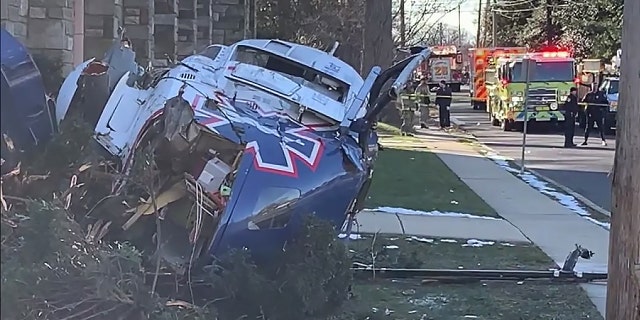The pilot who crash-landed a medical helicopter without any loss of life last in Philadelphia last week thanked his flight crew, first responders and God as his “co-pilot” on Sunday as he was released from the hospital.
Daniel Moore was greeted with applause from police and other first responders as the wheelchair-bound pilot was carted out of Penn Presbyterian Medical Center’s emergency room on Sunday. Before he was taken home by a police-escorted ambulance, he told reporters he was feeling “fortunate.”
“I had God as my co-pilot that day,” he said, “and we took care of the crew and we landed in his front yard, so that was kind of nice.”
INVESTIGATORS PROBE WRECKAGE OF CRASHED MEDICAL HELICOPTER
The Eurocopter EC135 medical helicopter owned by Denver-based Air Methods, part of the LifeNet program based in Hagerstown, Maryland, was also transporting an infant girl and two other crew members. It went down at about 1 p.m. local time Tuesday next to a church, Drexel Hill United Methodist Church in Upper Darby.
Moore said he didn’t remember “much of anything” about the crash, crediting other crew with rescuing him and getting the young patient to an ambulance.
PHILADELPHIA MEDICAL HELICOPTER CRASH INJURES 4, INCLUDING INFANT

Photo shows crash-landed helicopter on January 11, 2022
((Hank Flynn (FOX 29)))
The pilot’s injuries were most severe, but the other two adults and the baby girl were “miraculously unhurt,” Brian Rayner, senior safety investigator with the National Transportation Safety Board, told reporters last week.
An unidentified 911 caller told dispatchers immediately after the wreck that the pilot was the only passenger who did not seem alert, according to a 911 call excerpt released on Thursday.
“I remember waking up and looking up and seeing a whole company of firefighters looking down at me and that’s a real good feeling,” Moore said Sunday, as he expressed thanks to first responders and the medical team treating him.
CLICK HERE TO GET THE FOX NEWS APP
“I’m just glad to be here and I’m glad that I got my crew back alive,” he said. “I always tell people I just drive the bus; the heroes are in the back, working on the patient.”
The Associated Press contributed to this report.